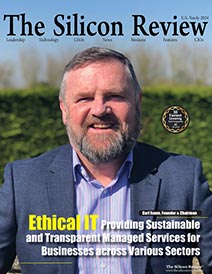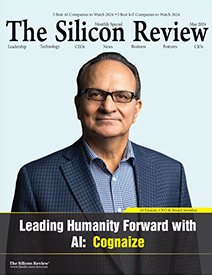‘Our Ability to Connect Accounting Teams will Lead to a Whole New Class of Applications’: Peter Horadan, CEO and Co-Founder of Lockstep®
The Silicon Review
![]()
“Lockstep transforms how accounting teams work together, creating connected access to invoices and payment platforms, creating a more efficient, connected process. And that’s connected accounting.”
Peter Horadan is the Chief Executive Officer and Co-Founder of Lockstep® — an award-winning company that connects accounting teams to help them work better together. From balancing his father’s columnar pads at age 12 to building some of the most-used financial software on Earth, Peter has been improving accounting software his entire life.
Before starting Lockstep, he was CTO and global head of engineering at Avalara, the leader in transactional tax management. Peter led the development of the SaaS version of Concur Expense, the worldwide leader in expense management. He also built some of the world’s first online banking software at Microsoft and authored international standards still in use today. Peter has a B.S. in Engineering from Rensselaer Polytechnic Institute.
Lockstep eliminates cash traps and leaks created from manual synchronization of books between B2B trading partners. The company’s connected accounting cloud empowers trusted, compliant accounting relationships between businesses of all sizes. Moreover, high-performance companies large and small run their collections with Lockstep.
The company is based in Seattle. It has additional office locations in Cleveland and India.
The Silicon Review reached out to Peter Horadan for his comments about how he plans to take Lockstep® to greater heights. Below is an excerpt.
Head to Head with Peter Horadan, CEO & Co-Founder
Q. What’s your story? And tell us what motivated you to establish Lockstep.
We started Lockstep because there are parts of accounting software that is broken. Today’s accounting systems treat businesses like they live on an island, when in fact; every business is connected. As buyers and sellers, bankers and clients, auditors and the audited, all businesses work together with other businesses. And as soon as you do that, your finances become connected. Even though businesses are connected, there’s no good way for businesses to work together in their accounting systems.
The tools used by the average accounting team today are grossly inefficient. The average accounts receivable or accounts payable (AR and AP) specialist is making do with a software stack that consists of emailing PDFs and spreadsheets back and forth to each other to be opened, read, and hand re-entered. What’s why we started Lockstep – to help the world’s accounting teams work together.
Q. What makes Lockstep unique? And how has it transformed accounting?
We’re accounting nerds. We have been doing this for decades and our motivation comes from wanting to help accounting teams that are suffering with terrible software.
While every department from sales to HR is getting great, new tools, the typical accounting team is stuck using antiquated software and systems. Lockstep is unique because we’re deeply committed to helping AR and AP teams.
Our focus is on the people; helping these accounting teams evolve and find efficiencies. It leads to fantastic results and all of those things that follow, but giving the people, the AR and AP teams, the tools needed to be able to do their job in the 21st century.
Q. What can you tell us about connected accounting? And how does Lockstep make accounting more accurate and timely, improve cash flow, and free staff to focus on high-value activities?
Every business activity results in the sharing of accounting information.
For example, if I am a seller and you are a buyer, my AR balance should match your AP balance. If I have given you 36 invoices, those need to be in my computer system and yours. But the only way that accountants have to share information today, is to email PDFs back and forth to each other, and open them, read them, and manually enter them into whatever their ERP system is.
This is nonsense. Lockstep transforms how accounting teams work together, creating connected access to invoices and payment platforms, creating a more efficient, connected process. And that’s connected accounting.
Lockstep’s accounts receivable automation software enables customers to automate AR communications, delivers enhanced online payment capabilities, and automates case applications to modernize collections. This strategy allows customers to reduce days sales outstanding (DSO) by 30 percent or more, improve visibility, and increase cash on hand. Through Lockstep, organizations are able to:
- Connect with more customers, faster using automated communications.
- Connect customers directly to their accounts online to accelerate payment timeliness and accuracy.
- Connect customer remittance to the right invoice automatically, making real-time payments a reality.
- Connect key internal stakeholders with visibility into cash flow and DSO through custom reports and automated distribution.
Q. From your perspective, how is the industry you serve currently evolving? And what are the trends in the different categories?
In 2011, Marc Andreesen said, “Software is eating the world.” And it seems that accounting has been left for dessert. Until recently, accounting had been left behind in the software automation of the last 20 years.
Online banking is 20 years old. The basic ability to share your bank balance happened 20 years ago. But even today, there’s no online system for sharing invoices. So, we are just in the early days of how software and automation can help accountants work together and how we can help them create whole new ways of working together.
Q. How do you plan to counter challenges that you think Lockstep might face in the next five years?
I have been involved in the creation of several APIs and what is key is thinking through not just what people are going to do today, but what they are going to try to do tomorrow and figuring out how to build in enough flexibility. People will create new applications five years from now that you can’t even think of today.
When the iPhone first came out, did anyone envision the connected driving apps that we have today where our phones are automatically sharing real-time information? Not at all.
For Lockstep, we are building for the future conversation around connected accounting. Our ability to connect accounting teams will lead to a whole new class of applications.
For more details visit : lockstep.io









